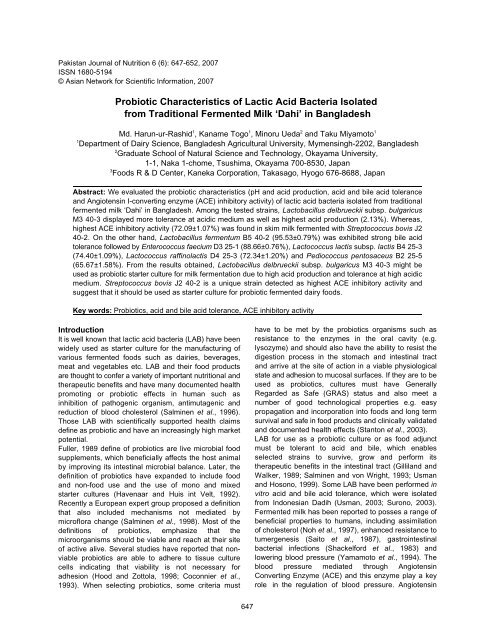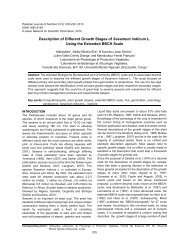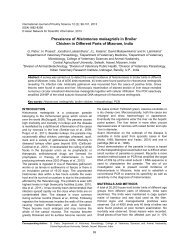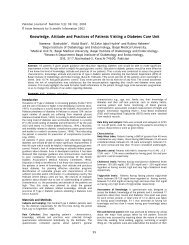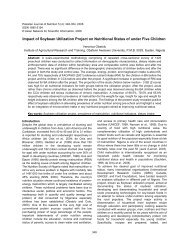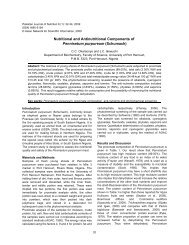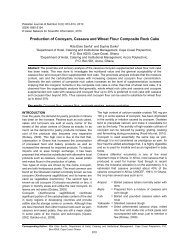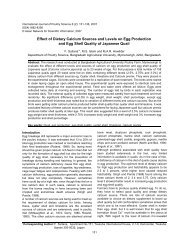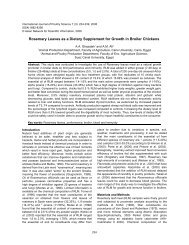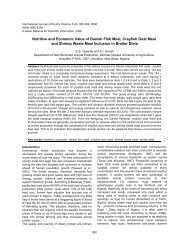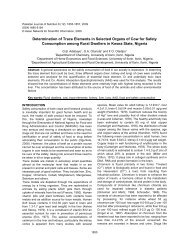Probiotic characteristics of lactic acid bacteria isolated from tra
Probiotic characteristics of lactic acid bacteria isolated from tra
Probiotic characteristics of lactic acid bacteria isolated from tra
You also want an ePaper? Increase the reach of your titles
YUMPU automatically turns print PDFs into web optimized ePapers that Google loves.
Pakistan Journal <strong>of</strong> Nutrition 6 (6): 647-652, 2007<br />
ISSN 1680-5194<br />
© Asian Network for Scientific Information, 2007<br />
<strong>Probiotic</strong> Characteristics <strong>of</strong> Lactic Acid Bacteria Isolated<br />
<strong>from</strong> Traditional Fermented Milk ‘Dahi’ in Bangladesh<br />
1 1 2 1<br />
Md. Harun-ur-Rashid , Kaname Togo , Minoru Ueda and Taku Miyamoto<br />
1<br />
Department <strong>of</strong> Dairy Science, Bangladesh Agricultural University, Mymensingh-2202, Bangladesh<br />
2<br />
Graduate School <strong>of</strong> Natural Science and Technology, Okayama University,<br />
1-1, Naka 1-chome, Tsushima, Okayama 700-8530, Japan<br />
3<br />
Foods R & D Center, Kaneka Corporation, Takasago, Hyogo 676-8688, Japan<br />
Abs<strong>tra</strong>ct: We evaluated the probiotic <strong>characteristics</strong> (pH and <strong>acid</strong> production, <strong>acid</strong> and bile <strong>acid</strong> tolerance<br />
and Angiotensin I-converting enzyme (ACE) inhibitory activity) <strong>of</strong> <strong>lactic</strong> <strong>acid</strong> <strong>bacteria</strong> <strong>isolated</strong> <strong>from</strong> <strong>tra</strong>ditional<br />
fermented milk ‘Dahi’ in Bangladesh. Among the tested s<strong>tra</strong>ins, Lactobacillus delbrueckii subsp. bulgaricus<br />
M3 40-3 displayed more tolerance at <strong>acid</strong>ic medium as well as highest <strong>acid</strong> production (2.13%). Whereas,<br />
highest ACE inhibitory activity (72.09±1.07%) was found in skim milk fermented with Streptococcus bovis J2<br />
40-2. On the other hand, Lactobacillus fermentum B5 40-2 (95.53±0.79%) was exhibited strong bile <strong>acid</strong><br />
tolerance followed by Enterococcus faecium D3 25-1 (88.66±0.76%), Lactococcus lactis subsp. lactis B4 25-3<br />
(74.40±1.09%), Lactococcus raffinolactis D4 25-3 (72.34±1.20%) and Pediococcus pentosaceus B2 25-5<br />
(65.67±1.58%). From the results obtained, Lactobacillus delbrueckii subsp. bulgaricus M3 40-3 might be<br />
used as probiotic starter culture for milk fermentation due to high <strong>acid</strong> production and tolerance at high <strong>acid</strong>ic<br />
medium. Streptococcus bovis J2 40-2 is a unique s<strong>tra</strong>in detected as highest ACE inhibitory activity and<br />
suggest that it should be used as starter culture for probiotic fermented dairy foods.<br />
Key words: <strong>Probiotic</strong>s, <strong>acid</strong> and bile <strong>acid</strong> tolerance, ACE inhibitory activity<br />
Introduction<br />
It is well known that <strong>lactic</strong> <strong>acid</strong> <strong>bacteria</strong> (LAB) have been<br />
widely used as starter culture for the manufacturing <strong>of</strong><br />
various fermented foods such as dairies, beverages,<br />
meat and vegetables etc. LAB and their food products<br />
are thought to confer a variety <strong>of</strong> important nutritional and<br />
therapeutic benefits and have many documented health<br />
promoting or probiotic effects in human such as<br />
inhibition <strong>of</strong> pathogenic organism, antimutagenic and<br />
reduction <strong>of</strong> blood cholesterol (Salminen et al., 1996).<br />
Those LAB with scientifically supported health claims<br />
define as probiotic and have an increasingly high market<br />
potential.<br />
Fuller, 1989 define <strong>of</strong> probiotics are live microbial food<br />
supplements, which beneficially affects the host animal<br />
by improving its intestinal microbial balance. Later, the<br />
definition <strong>of</strong> probiotics have expanded to include food<br />
and non-food use and the use <strong>of</strong> mono and mixed<br />
starter cultures (Havenaar and Huis int Velt, 1992).<br />
Recently a European expert group proposed a definition<br />
that also included mechanisms not mediated by<br />
micr<strong>of</strong>lora change (Salminen et al., 1998). Most <strong>of</strong> the<br />
definitions <strong>of</strong> probiotics, emphasize that the<br />
microorganisms should be viable and reach at their site<br />
<strong>of</strong> active alive. Several studies have reported that nonviable<br />
probiotics are able to adhere to tissue culture<br />
cells indicating that viability is not necessary for<br />
adhesion (Hood and Zottola, 1998; Coconnier et al.,<br />
1993). When selecting probiotics, some criteria must<br />
have to be met by the probiotics organisms such as<br />
resistance to the enzymes in the oral cavity (e.g.<br />
lysozyme) and should also have the ability to resist the<br />
digestion process in the stomach and intestinal <strong>tra</strong>ct<br />
and arrive at the site <strong>of</strong> action in a viable physiological<br />
state and adhesion to mucosal surfaces. If they are to be<br />
used as probiotics, cultures must have Generally<br />
Regarded as Safe (GRAS) status and also meet a<br />
number <strong>of</strong> good technological properties e.g. easy<br />
propagation and incorporation into foods and long term<br />
survival and safe in food products and clinically validated<br />
and documented health effects (Stanton et al., 2003).<br />
LAB for use as a probiotic culture or as food adjunct<br />
must be tolerant to <strong>acid</strong> and bile, which enables<br />
selected s<strong>tra</strong>ins to survive, grow and perform its<br />
therapeutic benefits in the intestinal <strong>tra</strong>ct (Gilliland and<br />
Walker, 1989; Salminen and von Wright, 1993; Usman<br />
and Hosono, 1999). Some LAB have been performed in<br />
vitro <strong>acid</strong> and bile <strong>acid</strong> tolerance, which were <strong>isolated</strong><br />
<strong>from</strong> Indonesian Dadih (Usman, 2003; Surono, 2003).<br />
Fermented milk has been reported to posses a range <strong>of</strong><br />
beneficial properties to humans, including assimilation<br />
<strong>of</strong> cholesterol (Noh et al., 1997), enhanced resistance to<br />
tumergenesis (Saito et al., 1987), gastrointestinal<br />
<strong>bacteria</strong>l infections (Shackelford et al., 1983) and<br />
lowering blood pressure (Yamamoto et al., 1994). The<br />
blood pressure mediated through Angiotensin<br />
Converting Enzyme (ACE) and this enzyme play a key<br />
role in the regulation <strong>of</strong> blood pressure. Angiotensin<br />
647
Rashid et al.: Lactic Acid Bacteria Isolated <strong>from</strong> Traditional Fermented Milk<br />
Table 1: pH and <strong>acid</strong>ity (%) <strong>of</strong> selected LAB s<strong>tra</strong>ins <strong>isolated</strong> <strong>from</strong> <strong>tra</strong>ditional fermented milk ‘Dahi’ in Bangladesh<br />
pH Acidity (%)<br />
---------------------------------------- -----------------------------------<br />
Name <strong>of</strong> species 24 h 48 h 72 h 24 h 48 h 72 h<br />
Streptococcus bovis J2 40-2 (37°C)* 4.27 4.18 4.15 1.09 1.14 1.14<br />
Streptococcus thermophilus M1 40-2 (37°C) 3.92 3.90 3.72 1.26 1.48 1.52<br />
Lactobacillus fermentum B5 40-2 (37°C) 5.48 4.98 4.55 0.53 0.76 0.80<br />
Lactobacillus delbrueckii subsp. bulgaricus M3 40-3 (37°C) 3.63 3.61 3.35 1.87 2.09 2.13<br />
Lactobacillus del. subsp. lactis M6 40-3 (37°C) 3.68 3.63 3.45 1.64 2.00 2.04<br />
Lactobacillus species D6 40-4 (37°C) 4.58 4.63 4.08 0.70 0.73 0.77<br />
Enterococcus faecium D3 25-1 (30°C) 4.80 4.74 4.68 0.74 0.76 0.77<br />
Leuconostoc mesenteroides subsp. mesenteroides M8 25-4 (30°C) – 5.34 5.32 – 0.68 0.70<br />
Leuconostoc mes. subsp. dex<strong>tra</strong>nicum M7 25-1 (37°C) – 5.33 5.20 – 0.67 0.75<br />
Lactococcus lactis subsp. lactis B4 25-3 (30°C) 4.84 4.68 4.57 0.76 0.83 0.90<br />
Lactococcus raffinolactis D4 25-3 (30°C) 4.85 4.52 4.50 0.80 0.89 0.90<br />
Pediococcus pentosaceus B2 25-5 (30°C) – 5.95 5.83 – 0.64 0.66<br />
*Parenthesis indicates appropriate growth temperature<br />
Converting Enzyme (ACE) is found in the rennin <strong>of</strong> Natural Science and Technology, Okayama University,<br />
angiotensin system and several researchers have been Japan. All s<strong>tra</strong>ins were preserved in skim milk<br />
reported that fermented milk with probiotics LAB can containing 0.1% glutamic <strong>acid</strong> (Nacalai Tesque Co.<br />
exert ACE inhibitory effect.<br />
Japan) and stored at-20°C and-80°C for further<br />
To our knowledge, only one finding has been reported investigation. Each s<strong>tra</strong>in was subcultured twice in TYLG<br />
on identification and characterization <strong>of</strong> <strong>lactic</strong> <strong>acid</strong> broth [per L: 10 g tryptone (Difco), 5 g yeast ex<strong>tra</strong>ct<br />
<strong>bacteria</strong> <strong>isolated</strong> <strong>from</strong> <strong>tra</strong>ditional fermented milk ‘Dahi’ (Difco), 5 g lactose (Nacalai), 5 g glucose (Nacalai), 1 g<br />
17)<br />
in Bangladesh and noted that LAB isolates had Tween 80 (Nacalai), 0.1 g L-cysteine HCl (Nacalai)] at<br />
contained <strong>of</strong> twelve species. However, there is no their appropriate growth temperatures (Table 1) prior to<br />
existing any evidence to evaluate the probiotic experimental use.<br />
<strong>characteristics</strong> <strong>of</strong> these LAB isolates. To date, people<br />
living throughout the country have been consumed dahi Determination <strong>of</strong> <strong>acid</strong>ity and pH: A 24 h old active<br />
mainly as a desert food after typically Bangladeshi Polao culture <strong>of</strong> LAB s<strong>tra</strong>ins were inoculated (1%, v/v) into 10%<br />
dishes. Also this product is not commercially produced sterile reconstituted skim milk and incubated at 30 or<br />
and marketed in only products areas. Moreover, people 37°C depending on their optimal growth temperatures<br />
do not know the potential health benefits <strong>of</strong> dahi and for 72 h. Samples were withdrawn every 24 h, 48 and 72<br />
also other indigenous fermented milk products in h interval <strong>of</strong> incubation period. The pH <strong>of</strong> cultured<br />
Bangladesh yet. Thus, it is essential to investigate <strong>of</strong> reconstituted skim milk was measured by using Horiba<br />
such probiotics properties <strong>of</strong> <strong>isolated</strong> LAB <strong>from</strong> dahi. pH meter F.8 (Horiba Ltd. Japan) and <strong>acid</strong>ity was<br />
The aim <strong>of</strong> this work was to assess the probiotic determined <strong>of</strong> cultured reconstituted skim milk against<br />
<strong>characteristics</strong> such as production <strong>of</strong> <strong>acid</strong> and pH, <strong>acid</strong> the 0.1 N NaOH.<br />
and bile <strong>acid</strong> tolerance and ACE inhibitory activity <strong>of</strong> the<br />
selected LAB s<strong>tra</strong>ins <strong>isolated</strong> <strong>from</strong> <strong>tra</strong>ditional fermented Assay for <strong>acid</strong> tolerance: For the purpose <strong>of</strong> <strong>acid</strong><br />
milk ‘Dahi’ in Bangladesh.<br />
tolerance test, TYLG broth was adjusted to various pHs<br />
such as 3.0, 3.5, 4.0, 4.5 and 5.0 by using 0.1 N HCl and<br />
then sterilized by autoclave at 121°C for 15 min. Active<br />
cultures <strong>of</strong> LAB s<strong>tra</strong>ins were inoculated (1%, v/v) into pH<br />
adjusted TYLG broth medium and incubated at 30 or<br />
37°C depending on their optimal growth temperatures<br />
for 72 h. After that cell growth was observed into the<br />
medium by periodically and designated positive growth<br />
as (+) and no growth as (–).<br />
Materials and Methods<br />
Sources and maintenance <strong>of</strong> cultures: The twelve<br />
selected LAB s<strong>tra</strong>ins such as Streptococcus bovis J2 40-<br />
2, Streptococcus thermophilus M1 40-2, Lactobacillus<br />
fermentum B5 40-2, Lactobacillus delbrueckii subsp.<br />
bulgaricus M3 40-3, Lactobacillus delbrueckii subsp.<br />
lactis M6 40-3, Lactobacillus species D6 40-4,<br />
Enterococcus faecium D3 25-1, Leuconostoc<br />
mesenteroides subsp. mesenteroides M8 25-4,<br />
Leuconostoc mesenteroides subsp. dex<strong>tra</strong>nicum M7 25-<br />
1, Lactococcus lactis subsp. lactis B4 25-3, Lactococcus<br />
raffinolactis D4 25-3 and Pediococcus pentosaceus B2<br />
25-5 <strong>isolated</strong> <strong>from</strong> <strong>tra</strong>ditional fermented milk ‘Dahi’ used<br />
in the study were obtained <strong>from</strong> the stock cultures <strong>of</strong><br />
Animal Food Function Laboratory, The Graduate School<br />
Assay for bile <strong>acid</strong> tolerance: The effect <strong>of</strong> bile <strong>acid</strong><br />
tolerance on the growth rate <strong>of</strong> selected LAB according<br />
to the method described by Walker and Gilliland (1993).<br />
All cultures were evaluated for growth in MRS broth with<br />
0.3% (w/v) Oxgall (Difco, Sparks, MD. USA). Freshly<br />
prepared active cultures were inoculated (1%, v/v) into<br />
medium and incubated at their optimal growth<br />
648
Rashid et al.: Lactic Acid Bacteria Isolated <strong>from</strong> Traditional Fermented Milk<br />
Table 2: Acid and bile <strong>acid</strong> tolerance <strong>of</strong> selected LAB <strong>isolated</strong> <strong>from</strong> <strong>tra</strong>ditional fermented milk ‘Dahi’ in Bangladesh<br />
pH tolerance<br />
-------------------------------------------------<br />
Name <strong>of</strong> species 3.0 3.5 4.0 4.5 5.0 Bile <strong>acid</strong> tolerance (%)<br />
Streptococcus bovis J2 40-2 (37°C)* – – – – + 9.07±0.38<br />
Streptococcus thermophilus M1 40-2 (37°C) – – – + + 27.13±1.76<br />
Lactobacillus fermentum B5 40-2 (37°C) – – + + + 95.53±0.79<br />
Lactobacillus delbrueckii subsp. bulgaricus M3 40-3 (37°C) + + + + + 8.21±0.55<br />
Lactobacillus del. subsp. lactis M6 40-3 (37°C) – + + + + 6.38±0.28<br />
Lactobacillus species D6 40-4 (37°C) – – – + + 16.82±1.77<br />
Enterococcus faecium D3 25-1 (30°C) – – + + + 88.66±0.76<br />
Leuconostoc mesenteroides subsp. mesenteroides M8 25-4 (30°C) – – + + + 39.26±0.76<br />
Leuconostoc mes. subsp. dex<strong>tra</strong>nicum M7 25-1 (37°C) – – + + + 39.92±0.68<br />
Lactococcus lactis subsp. lactis B4 25-3 (30°C) – – + + + 74.40±1.09<br />
Lactococcus raffinolactis D4 25-3 (30°C) – – + + + 72.34±1.20<br />
Pediococcus pentosaceus B2 25-5 (30°C) – – + + + 65.67±1.58<br />
*Parenthesis indicates appropriate growth temperature<br />
temperatures (30 or 37°C) and determined their cell ACE inhibitory activity (%) = [(B-A) / (B-C)] ×100<br />
growth by optical density per hourly by<br />
spectrophotometrically at 620 nm. The growth was Where,<br />
monitored by followed 6 h incubation.<br />
A is the optical density in the presence <strong>of</strong> both ACE and<br />
ACE inhibitory compounds<br />
Measurement <strong>of</strong> ACE inhibitory activity: The selected B is the optical density without ACE inhibitory<br />
twelve LAB s<strong>tra</strong>ins <strong>isolated</strong> <strong>from</strong> <strong>tra</strong>ditional fermented compounds<br />
milk ‘Dahi’ were used for the measurement <strong>of</strong> ACE C is the optical density without ACE and ACE<br />
inhibitory activity. We routinely propagated lactobacilli in compounds<br />
MRS (Oxoid, Hampshire, England) and lactococci in<br />
GM17 broth (Difco, England) for 24 h at their optimal<br />
growth temperatures (30 or 37°C). Twenty-four-hour old<br />
active cultures <strong>of</strong> selected LAB was used to inoculate<br />
(1%, v/v) into 10 ml <strong>of</strong> 10% reconstituted skim milk<br />
media, which was incubated at 30 or 37°C for 72 h.<br />
ACE inhibitory activity was measured according to the<br />
method <strong>of</strong> Nakamura et al. (1995) with some<br />
modifications. Fermented skim milk was adjusted to pH<br />
4.6 by adding 1 N NaOH or 1 N HCl and then centrifuged<br />
at 12,000×g for 20 min at 4°C. The whey supernatant<br />
was adjusted to pH 8.3 with 5 N NaOH and was given<br />
12,000×g for 20 min in a bench centrifuge. The<br />
supernatant was used in the assay <strong>of</strong> ACE inhibitory<br />
activity. Hip-His-Leu was dissolved (50 mM) in 100 mM<br />
Na-borate buffer (pH 8.3) containing 300 mM NaCl. A<br />
sample (60 µl) was mixed with 200 µl <strong>of</strong> Hip-His-Leu<br />
solution and 40 µl <strong>of</strong> ACE (25 mM). The mixture was<br />
incubated at 37°C for 1 h. After incubation 250 µl <strong>of</strong> 1 N<br />
HCl was added to stop the reaction. The hippuric <strong>acid</strong><br />
Results<br />
Acid production and pH <strong>of</strong> skim milk fermented by<br />
LAB: Table 1 showed the pH and <strong>acid</strong>ity <strong>of</strong> skim milk<br />
fermented with selected 12 LAB species <strong>isolated</strong> <strong>from</strong><br />
<strong>tra</strong>ditional fermented milk ‘Dahi’. Among them, Lb.<br />
delbrueckii subsp. bulgaricus M3 40-3 could produced<br />
the highest <strong>acid</strong> production (2.13%) and at the same<br />
time decreased their pH <strong>from</strong> 6.0 to 3.35 in fermented<br />
skim milk when incubated at 37°C for 72 h. However,<br />
highest pH (5.83) and lowest <strong>acid</strong>ity (0.66%) were<br />
recorded in skim milk fermented with P. pentosaceus B2<br />
25-5, incubated at their optimal growth temperature for<br />
72 h. Leuc. mesenteroides subsp. mesenteroides M8<br />
25-4 and Leuc. mesenteroides subsp. dex<strong>tra</strong>nicum M7<br />
25-1 could unable to coagulate the skim milk up to 24 h<br />
incubation, while hard coagulation was observed in<br />
skim milk fermented with both Lc. lactis subsp. lactis B4<br />
25-3 and Lc. raffinolactis D4 25-3 at early 24 h<br />
incubation.<br />
was liberated by ACE was ex<strong>tra</strong>cted with 1.7 ml <strong>of</strong> ethyl<br />
acetate. After centrifugation (5,000×g for 20 min) 0.5 ml<br />
<strong>of</strong> the upper layer was <strong>tra</strong>nsferred into a test tube and<br />
evaporated at room temperature for 20 min in rotary<br />
vacuum evaporator. The hippuric <strong>acid</strong> was diluted in 1.0<br />
ml sterile distilled water and the absorbance was<br />
Acid tolerance <strong>of</strong> selected LAB <strong>isolated</strong> <strong>from</strong><br />
<strong>tra</strong>ditional fermented milk ‘Dahi’: Acid tolerance <strong>of</strong> 12<br />
selected LAB species are showed in Table 2. TYLG<br />
broth with various initial pH inoculated (1%, v/v) by active<br />
cultures <strong>of</strong> the selected LAB were found a variable<br />
measured at 228 nm using on UV results after 72 h incubation. Lb. delbrueckii subsp.<br />
spectrophotometrically (U-1800 Spectrophotometer, bulgaricus M3 40-3 was exhibited to growth at the wide<br />
Hitachi Co. Ltd. Japan). The percentage <strong>of</strong> ACE inhibitory<br />
activity was calculated by following formula:<br />
ranges <strong>of</strong> pH (3.0 to 5.0). While, S. bovis J2 40-2 could<br />
growth only at pH 5.0. On the other hand, S.<br />
649
Rashid et al.: Lactic Acid Bacteria Isolated <strong>from</strong> Traditional Fermented Milk<br />
Table 3: ACE inhibitory activity <strong>of</strong> selected LAB s<strong>tra</strong>ins <strong>isolated</strong> <strong>from</strong> <strong>tra</strong>ditional fermented milk ‘Dahi’ in Bangladesh<br />
ACE inhibitory ACE inhibitory activity (%)<br />
Name <strong>of</strong> species activity (%) Pre-incubation method<br />
Streptococcus bovis J2 40-2 (37°C)* 72.09±1.07 45.37±0.62<br />
Streptococcus thermophilus M1 40-2 (37°C) 18.19±0.41 –<br />
Lactobacillus fermentum B5 40-2 (37°C) 50.60±1.14 15.37±0.83<br />
Lactobacillus delbrueckii subsp. bulgaricus M3 40-3 (37°C) 31.54±0.95 –<br />
Lactobacillus del. subsp. lactis M6 40-3 (37°C) 31.57±1.09 –<br />
Lactobacillus species D6 40-4 (37°C) 47.55±0.76 16.90±1.29<br />
Enterococcus faecium D3 25-1 (30°C) 52.37±1.01 –<br />
Leuconostoc mesenteroides subsp. mesenteroides M8 25-4 (30°C) 47.40±0.96 22.46±1.11<br />
Leuconostoc mes. subsp. dex<strong>tra</strong>nicum M7 25-1 (37°C) 30.35±0.79 20.48±1.01<br />
Lactococcus lactis subsp. lactis B4 25-3 (30°C) – –<br />
Lactococcus raffinolactis D4 25-3 (30°C) – –<br />
Pediococcus pentosaceus B2 25-5 (30°C) – –<br />
*Parenthesis indicates appropriate growth temperature<br />
thermophilus M1 40-2, Lb. species D6 40-4, Lb. <strong>tra</strong>ditional fermented milk ‘Dahi’ in Bangladesh. One<br />
fermentum B5 40-2, Ec. faecium D3 25-1, Leuc. representative s<strong>tra</strong>in <strong>from</strong> each species group was<br />
mesenteroides subsp. mesenteroides M8 25-4, Leuc. selected for the evaluation <strong>of</strong> probiotic <strong>characteristics</strong> in<br />
mesenteroides subsp. dex<strong>tra</strong>nicum M7 25-1 and P. the present study. Results <strong>from</strong> this study revealed that<br />
pentosaceus B2 25-5 could not grow at pH 3.0 to 4.0 but Lb. delbrueckii subsp. bulgaricus M3 40-3 was<br />
well grown at pH 4.0 to 5.0.<br />
produced highest <strong>acid</strong> production among the lactobacilli<br />
and S. thermophilus M140-2 among the lactococci.<br />
Bile <strong>acid</strong> tolerance <strong>of</strong> selected LAB <strong>isolated</strong> <strong>from</strong> Bacteria would contact pH values ranging <strong>from</strong> 2.0 to 8.0<br />
<strong>tra</strong>ditional fermented ‘Dahi’: Bile <strong>acid</strong> tolerances (0.3% in the gastrointestinal <strong>tra</strong>ct if consumed (Hood and<br />
Oxgall) <strong>of</strong> selected LAB stains are shown in Table 2. Zottola, 1988). On the other hand, Lb. delbrueckii subsp.<br />
From the results, Lb. fermentum B5 40-2 was exhibited bulgaricus M3 40-3 could able to survive more <strong>acid</strong>ic<br />
the highest bile <strong>acid</strong> tolerance (95.53±0.79%) followed medium among the tested s<strong>tra</strong>ins <strong>of</strong> LAB. Besides, S.<br />
by Ec. faecium D3 25-1 (88.66±0.76%), Lc. lactis subsp. bovis J2 40-2 could produced low <strong>acid</strong> production and<br />
lactis B4 25-3 (74.40±1.09%), Lc. raffinolactis D4 25-3 exhibited low bile <strong>acid</strong> tolerance, while Lb. fermentum<br />
(72.34±1.20%) and P. pentosaceus B2 25-5 B5 40-2 was exhibited the highest bile <strong>acid</strong> tolerance.<br />
(65.67±1.58%). Lowest bile <strong>acid</strong> tolerances were Thus probiotic cultures must survive in the environment<br />
observed by Lb. delbrueckii subsp. lactis M6 40-3 with gastric and bile <strong>acid</strong>s, when viable cells go through<br />
(6.38±0.28%), Lb. delbrueckii subsp. bulgaricus M3 40- the gastrointestinal <strong>tra</strong>ct. Resisting at pH 3.0 and<br />
3 (8.21±0.55%), S. bovis J2 40-2 (9.07±0.38%) and Lb. growing in the medium containing 0.1% bile <strong>acid</strong>s are<br />
species D6 40-4 (16.82±1.77%).<br />
considered as standards for <strong>acid</strong> and bile <strong>acid</strong> tolerance<br />
<strong>of</strong> probiotic culture (Itoh, 1992; Gohran, 1994).<br />
ACE inhibitory activity: Table 3 represented the ACE Meanwhile, Lb. delbrueckii subsp. bulgaricus M3 40-3<br />
inhibitory activity <strong>of</strong> selected LAB s<strong>tra</strong>ins <strong>isolated</strong> <strong>from</strong> has good <strong>acid</strong> tolerance and less bile <strong>acid</strong> tolerance<br />
<strong>tra</strong>ditional fermented milk ‘Dahi’. Of the selected LAB (0.3% Oxgall). Thus this s<strong>tra</strong>in must be survived at high<br />
isolates, S. bovis J2 40-2 was exhibited the highest ACE <strong>acid</strong>ic environment in the stomach and low<br />
inhibitory activity (72.09±1.07%) <strong>of</strong> fermented skim milk concen<strong>tra</strong>tion <strong>of</strong> bile components in the intestine when<br />
in respects to all s<strong>tra</strong>ins. No ACE inhibitory activity was consumed fermented foods containing <strong>of</strong> this s<strong>tra</strong>in.<br />
determined by the species <strong>of</strong> Lc. lactis subsp. lactis B4 Milk fermented with S. bovis J2 40-2, Lb. fermentum B5<br />
25-3, Lc. raffinolactis D4 25-3 and P. pentosaceus B2 25- 40-2, Lb. species D6 40-4, Ec. faecium D3 25-1 and<br />
5 in the fermented skim milk. ACE inhibitory activity could Leuc. mesenteroides subsp. mesenteroides M8 25-4<br />
not measure when ACE determined by preincubation were exhibited higher ACE inhibitory activity. It has been<br />
method <strong>of</strong> the s<strong>tra</strong>ins <strong>of</strong> Lb. delbrueckii subsp. reported that unfermented milk apparently exhibited<br />
bulgaricus M3 40-3, Lb. delbrueckii subsp. lactis M6 40- slight ACE inhibitory activity and the ACE inhibitory activity<br />
3, S. thermophilus M1 40-2 and Ec. faecium D3 25-1. was markedly increased during fermentation by<br />
However, there was no significance difference <strong>of</strong> ACE probiotics LAB (Nakamura et al., 1995). Studies to<br />
inhibitory activity <strong>of</strong> S. bovis J2 40-2 by determined <strong>of</strong> demons<strong>tra</strong>te that probiotics supplementation can affect<br />
different methods such as preincubation method. plasma cholesterol concen<strong>tra</strong>tions and consequently<br />
the incidence <strong>of</strong> blood pressure and coronary heart<br />
Discussion<br />
disease. These results clearly indicated that<br />
Rashid et al. (2007) reported in our previous study that<br />
12 species <strong>of</strong> <strong>lactic</strong> <strong>acid</strong> <strong>bacteria</strong> were <strong>isolated</strong> <strong>from</strong><br />
fermentation plays an important role to release <strong>of</strong> ACE<br />
inhibitory peptides <strong>from</strong> milk proteins by microbial<br />
650
Rashid et al.: Lactic Acid Bacteria Isolated <strong>from</strong> Traditional Fermented Milk<br />
proteinases. Fuglsang et al. (2003) reported that two<br />
s<strong>tra</strong>ins <strong>of</strong> Lb. helveticus capable <strong>of</strong> producing fermented<br />
milk with in vivo activity against ACE have been identified<br />
and highly significant blood pressure effects were<br />
observed. However, the activity and thus the in vivo<br />
potential <strong>of</strong> the fermented milk, varies with the s<strong>tra</strong>in.<br />
Similarly, in the present study, some s<strong>tra</strong>ins <strong>of</strong> LAB are<br />
able to produce ACE inhibitory compounds during milk<br />
fermentation. It has been reported that milk fermentation<br />
with Lb. helveticus proved highly hypotensive in a cuff<br />
study, with a drop <strong>of</strong> up to about 30 mm Hg in systolic<br />
blood pressure in spontaneous hypertensive rats<br />
(Yamamoto et al., 1994; Nakamura et al., 1995).<br />
Therefore, inhibition <strong>of</strong> ACE results in promoting the<br />
vasodilatory effect, leading to the treatment <strong>of</strong> high blood<br />
pressure in human and animals. LAB are known to<br />
produce that ACE inhibitors <strong>of</strong> the enzyme in various<br />
amounts during milk fermentation (Yamamoto et al.,<br />
1994; Meisel et al., 1997; Gobbetti et al., 2000). Several<br />
researchers suggested that probiotics LAB can be used<br />
for producing potent ACE inhibitory peptides <strong>from</strong> milk<br />
proteins for the regulation <strong>of</strong> blood pressure.<br />
Conclusions: To our knowledge, this is the first report to<br />
evaluate the probiotic properties <strong>of</strong> <strong>lactic</strong> <strong>acid</strong> <strong>bacteria</strong><br />
<strong>isolated</strong> <strong>from</strong> <strong>tra</strong>ditional fermented milk ‘Dahi’. Among<br />
them, Lb. fermentum B5 40-2, Lb. delbrueckii subsp.<br />
bulgaricus M3 40-3 and S. bovis J2 40-2 were exhibited<br />
good probiotic <strong>characteristics</strong> that might be used for<br />
food or dairy fermentation and contribute health benefits<br />
to consumers. The s<strong>tra</strong>in <strong>of</strong> S. bovis J2 40-2 showed<br />
with certainty the production <strong>of</strong> ACE inhibitory<br />
compounds followed by Ec. faecium D3 25-1, Lb.<br />
fermentum B5 40-2, Lb. species D6 40-4 and Leuc.<br />
mesenteroides subsp. mesenteroides M8 25-4 and can<br />
be used for producing potent ACE inhibitory peptides.<br />
Further work will be addressed the purification and<br />
amino <strong>acid</strong> sequences <strong>of</strong> ACE inhibitory<br />
peptides/compounds in milk fermentation with these<br />
s<strong>tra</strong>ins. Moreover, beneficial health effect <strong>of</strong> dahi and its<br />
<strong>lactic</strong> <strong>acid</strong> <strong>bacteria</strong> is not understood well by the<br />
maximum Bangladeshi yet. Therefore, results <strong>from</strong> the<br />
present study are expected to encourage the people to<br />
consume more fermented milk dahi, as it was revealed<br />
that dahi contain some probiotic <strong>lactic</strong> <strong>acid</strong> <strong>bacteria</strong><br />
which play major role for beneficial health effects <strong>of</strong><br />
consumers.<br />
Acknowledgements<br />
The authors wish to thank the Ministry <strong>of</strong> Education,<br />
Culture, Sports, Science and Technology and Foods<br />
Research and Development Center, Kaneka<br />
Corporation, Japan for financial support.<br />
References<br />
Salminen, S., E. Isolauri and E. Salminen, 1996. Clinical<br />
uses <strong>of</strong> probiotics for stabilizing the gut mucosal<br />
barrier: successful stains and future challenges.<br />
Antonie van Leeuwenhoek, 70: 251-262.<br />
Fuller, R., 1989. <strong>Probiotic</strong>s in man and animals. J. Appl.<br />
Bacteriol., 66: 365-378.<br />
Havenaar, R. and J. Huis in’t Velt, 1992. <strong>Probiotic</strong>s: A<br />
general view. In wood ed. The <strong>lactic</strong> <strong>acid</strong> <strong>bacteria</strong> in<br />
health and disease. London Elsevier Appl. Sci., pp:<br />
209-224.<br />
Salminen, S., A.C. Ouwehand and E. Isolauri, 1998.<br />
Clinical applications <strong>of</strong> probiotic <strong>bacteria</strong>. Inter.<br />
Dairy J., 8: 563-572.<br />
Hood, S.K. and E.A. Zottola, 1988. Effect <strong>of</strong> low pH on the<br />
ability <strong>of</strong> Lactobacillus <strong>acid</strong>ophilus to survive and<br />
adhere human intestinal cells. J. Food Sci., 53:<br />
1514-1516.<br />
Coconnier, M.H., M.F. Bernet, S. Kerneis, G. Chauviere,<br />
J. Fourniat and A.L. Servin, 1993. Inhibition <strong>of</strong><br />
adhesion <strong>of</strong> enteroinvasive pathogens to human<br />
intestinal Caco-2 cells by Lactobacillus <strong>acid</strong>ophilus<br />
s<strong>tra</strong>in LB decreases <strong>bacteria</strong>l invasion. FEMS<br />
Microbiology Letters, 110: 299-305.<br />
Stanton, C., C. Desmond, M. Coakley, J.K. Collins, G.<br />
Fitzgerald and R.P. Ross, 2003. Challenges facing<br />
development <strong>of</strong> probiotic-containing functional<br />
foods. In Handbook <strong>of</strong> feremented functional foods.<br />
Ed. Farnworth, E.R. Florida, CRC press, pp: 27-58.<br />
Gilliland, S.E. and D.K. Walker, 1989. Factor to consider<br />
when selecting a culture <strong>of</strong> Lactobacillus<br />
<strong>acid</strong>ophilus as a dietary adjunct to produce a<br />
hypocholesterolemic effect in humans. J. Dairy Sci.,<br />
73: 905-911.<br />
Salminen, S. and A. von Wright, 1993. Lactic <strong>acid</strong><br />
<strong>bacteria</strong>. Marcel Dekker, Inc., New York, Basel, Hong<br />
Kong.<br />
Usman, P. and A. Hosono, 1999. Bile tolerance,<br />
taurocholate deconjugation and binding <strong>of</strong><br />
cholesterol by Lactobacillus gasseri s<strong>tra</strong>ins. J. Dairy<br />
Sci., 82: 956-961.<br />
Surono, S.I., 2003. In vitro probitic properties <strong>of</strong><br />
indigenous dadih <strong>lactic</strong> <strong>acid</strong> <strong>bacteria</strong>. Asian-<br />
Aus<strong>tra</strong>lasian J. Anim. Sci., 16: 726-731.<br />
Usman, P., 2003. Bile and <strong>acid</strong> tolerance <strong>of</strong> <strong>lactic</strong> <strong>acid</strong><br />
<strong>bacteria</strong> <strong>isolated</strong> <strong>from</strong> Dadih and their<br />
antimutagenicity against mutagenic heated Tauco.<br />
Asian-Aus<strong>tra</strong>lasian J. Anim. Sci., 16: 1680-1685.<br />
Noh, D.O., S.H. Kim and S.E. Gilliland, 1997.<br />
Incorporation <strong>of</strong> cholesterol into the cellular<br />
membrane <strong>of</strong> Lactobacillus <strong>acid</strong>ophilus ATCC<br />
43121. J. Dairy Sci., 80: 3107-3113.<br />
Saito, H., H. Tomioka and K. Nagashima, 1987.<br />
Protective and therapeutic efficacy <strong>of</strong> Lactobacillus<br />
casei against experimental infections due to<br />
Mycobacterium fortuitum complex. J. Gen.<br />
Microbiol., 133: 2843-2851.<br />
651
Rashid et al.: Lactic Acid Bacteria Isolated <strong>from</strong> Traditional Fermented Milk<br />
Shackelford, L.A., D.R. Rao, C.B. Chawan and S.R. Itoh, T., 1992. Functional benefits <strong>from</strong> <strong>lactic</strong> <strong>acid</strong><br />
Pulusani, 1983. Effect <strong>of</strong> feeding fermented milk on <strong>bacteria</strong> used in cultured milk. Anim. Sci. Technol.,<br />
the incidence <strong>of</strong> chemically induced colon tumors in 63: 1276-1289.<br />
rats. Nutr. Cancer, 5: 159-164.<br />
Gohran, M., 1994. Lactobacillus with the ability <strong>of</strong><br />
Yamamoto, N., A. Akino and T. Takano, 1994. colonization and establishing in the intestinal <strong>tra</strong>cts.<br />
Antihypertensive effect <strong>of</strong> different kinds <strong>of</strong> Japan Patent, 6: 501-624.<br />
fermented milk in spontaneously hypertensive rats. Fuglsang, A., F.P. Rat<strong>tra</strong>y, D. Nilsson and N.C.B. Nyborg,<br />
Biosci. Biotechnol. Biochem., 58: 776-778.<br />
2003. Lactic <strong>acid</strong> <strong>bacteria</strong>: inhibition <strong>of</strong> angiotensin<br />
Rashid, M.H., K. Togo, M. Ueda and T. Miyamoto, converting enzyme in vitro and in vivo. Antonie van<br />
2007. Identification and characterization <strong>of</strong> <strong>lactic</strong> Leeuwenhoek, 83: 27-34.<br />
<strong>acid</strong> <strong>bacteria</strong> <strong>isolated</strong> <strong>from</strong> <strong>tra</strong>ditional fermented Gobbetti, M., P. Ferranti, E. Smacchi and F. G<strong>of</strong>fredi,<br />
milk ‘Dahi’ in Bangladesh. World J. Microbiol. 2000. Production <strong>of</strong> angiotensin-I converting<br />
Biotechnol., 23: 125-133.<br />
enzyme inhibitory peptides in fermented milks<br />
Walker, D.R. and S.E. Gilliland, 1993. Relationship started by Lactobacillus delbrueckii subsp<br />
among bile tolerance, bile salt deconjugation and bulgaricus SS1 and Lactococcus lactis subsp<br />
assimilation <strong>of</strong> cholesterol by Lactobacillus cremoris FT5. Appl. Environ. Microbiol., 66: 3898-<br />
<strong>acid</strong>ophilus. J. Dairy Sci., 76: 956-961. 3904.<br />
Nakamura, Y., N. Yamamoto, K. Sakai, A. Okubo, S. Meisel, H., A. Goepfert and S. Gunther, 1997. ACE<br />
Yamazaki and T. Takano, 1995. Purification and inhibitory activities in milk products.<br />
characterization <strong>of</strong> angiotensin I-converting enzyme Milchwissenschaft, 52: 307-311.<br />
inhibitors <strong>from</strong> sour milk. J. Dairy Sci., 78: 777-783.<br />
652


